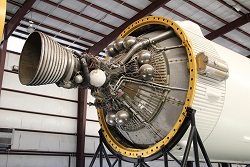The greening of solid rocket propellants?
The case for using solid propellants in space propulsion technology is easily pleaded: they are the most cost effective, competitive and reliable solution out there, period. However, there is one element in those propellants that increasingly receives bad press: ammonium perchlorate (AP). Besides its negative impact on the environment – it notably causes ozone depletion and acid rain formation – AP has also been linked to thyroid gland interference. As many as 270 tonnes of concentrated hydrochloric acid end up in the atmosphere with each launch of Ariane 5. This is deemed to have a negligible environmental impact at the global scale, but so is also the case for every polluting industry, and this argument is thus not a good example of a responsible environmental commitment. The fact that ammonium perchlorate also has been found in European vegetables certainly raises some questions. There are, unfortunately, very few alternatives to AP. Other oxidisers like ammonium dinitramide (ADN) and the oxidizer ammonium nitrate (AN) have the potential to be greener, but they cannot replace AP on their own. “Perchlorate has many good properties. It has a high density, burns in a suitable manner and is relatively safe to handle. ADN has very high performance but burns too fast to be used in a large rocket motor, whilst AN burns too slowly and has a very poor performance,” says Dr Niklas Wingborg, Deputy Research Director at the Swedish Defence Research Agency and coordinator of GRAIL. The idea behind the GRAIL project was to use a combination of ADN and AN, hoping that finding the right mixture would create a green oxidiser with properties similar to ammonium perchlorate. Unfortunately, the combustion properties of ADN and AN combined turned out to be very poor but this setback did not stop the project team from taking a different track in their research. “We tried to solve that by using different additives, but without success,” Dr Wingborg recalls. “We also found that ADN was more explosive sensitive than we had expected, so we were not able to use as much in the propellant as we had hoped for. As a consequence, we decided to develop a greener propellant instead of a fully green one. We mixed ADN and AP to obtain a propellant that has a higher performance and is 25 % greener than current AP based propellants.” Does that mean that a truly green solid propellant is out of reach? For the moment, it would seem so. As Dr Wingborg points out, developing a completely green propellant would require to master the combustion properties of ADN and AN, which would require further research. For the near future, it seems that green space propulsion can only be obtained using liquid propellants. However, some liquid fuels are fearfully toxic as hydrazine and its derivatives. Dr Wingborg thus would like to dedicate a potential new project to make these liquid fuels less toxic. In the meantime, GRAIL’s greener solid propellant might appeal to the defence industry, where it could be useful for future missile propulsion technology. “If we had been successful, our recommendation for the development of future launchers would be to go for the new green solid propellant. But in the GRAIL project we couldn’t make such propellant a reality, so my recommendation for civilian launchers currently using solid propellants would be to keep using them for the time being. If health, environmental concerns or public opinion ever make perchlorate unacceptable, then I would recommend to go for liquid propellants,” Dr Wingborg concludes.
Keywords
GRAIL, rocket propellant, ADN, AN, perchlorate, launcher



